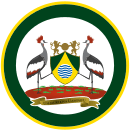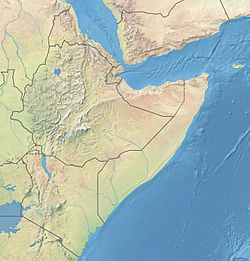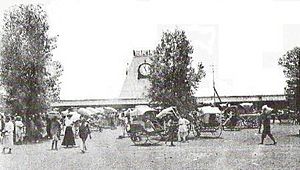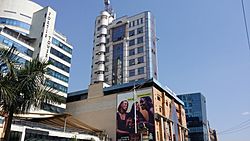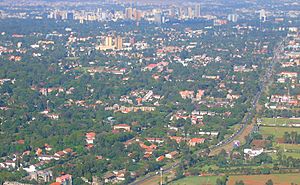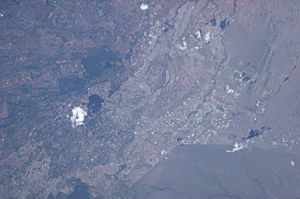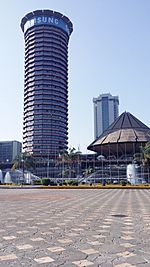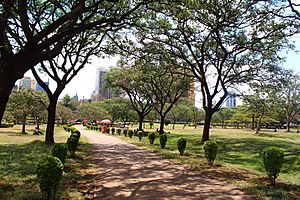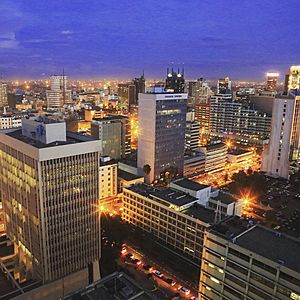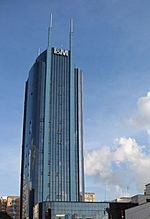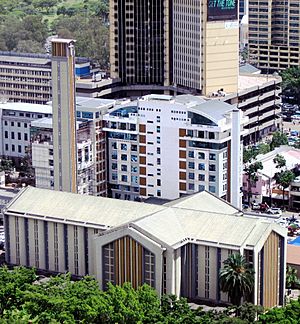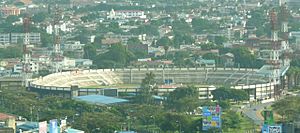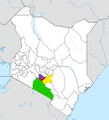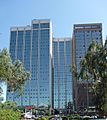Nairobi facts for kids
Quick facts for kids
Nairobi
|
|||
|---|---|---|---|
|
Consolidated city-county
|
|||
| City and County of Nairobi | |||
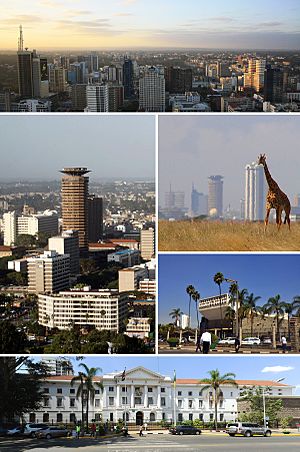
Clockwise from top: central business district; a giraffe walking in Nairobi National Park; Parliament of Kenya; Nairobi City Hall; and the Kenyatta International Conference Centre
|
|||
|
|||
| Nickname(s):
"The Green City under the Sun", "Safari Capital of the World"
|
|||
| Country | |||
| County | Nairobi | ||
| Founded | 1899 | ||
| Constituencies |
List
Dagoretti North
Dagoretti South Westlands Langata Kibera Roysambu Kasarani Ruaraka Embakasi South Embakasi North Embakasi Central Embakasi East Embakasi West Makadara Kamukunji Starehe Mathare |
||
| Government | |||
| • Body | Nairobi City County | ||
| Area | |||
| • Consolidated city-county | 696 km2 (269 sq mi) | ||
| Elevation | 1,795 m (5,500 ft) | ||
| Population
(2019)
|
|||
| • Consolidated city-county | 4,397,073 | ||
| • Density | 6,317.6/km2 (16,363/sq mi) | ||
| • Urban | 4,397,073 | ||
| • Metro | 10,400,676 | ||
| Demonym(s) | Nairobian | ||
| Time zone | UTC+3 (EAT) | ||
| Area code(s) | 020 | ||
| HDI (2018) | 0.644 - medium |
||
| GDP (2017) | 14.8 billion USD | ||
| Poverty Rate | 1.3 % - $1.90/day |
||
Nairobi ( ny-ROH-bee) is the capital and largest city of Kenya. The name comes from the Maasai phrase Enkare Nyorobi, which translates to "place of cool waters", a reference to the Nairobi River which flows through the city. The city proper had a population of 4,397,073 in the 2019 census, while the metropolitan area has a population of 9,354,580. The city is popularly referred to as the Green City in the Sun.
Nairobi was founded in 1899 by the colonial authorities in British East Africa, as a rail depot on the Uganda - Kenya Railway. The town quickly grew to replace Mombasa as the capital of Kenya in 1907. After independence in 1963, Nairobi became the capital of the Republic of Kenya. During Kenya's colonial period, the city became a centre for the colony's coffee, tea and sisal industry. The city lies in the south central part of Kenya, at an elevation of 1,795 metres (5,889 ft).
According to the 2019 census, in the administrative area of Nairobi, 4,397,073 inhabitants lived within 696 km2 (269 sq mi).
Nairobi is home of the Kenyan Parliament Buildings and hosts thousands of Kenyan businesses and over 100 major international companies and organizations, including the United Nations Environment Programme (UN Environment) and the United Nations Office at Nairobi (UNON). Nairobi is an established hub for business and culture. The Nairobi Securities Exchange (NSE) is one of the largest in Africa and the second-oldest exchange on the continent. It is Africa's fourth-largest exchange in terms of trading volume, capable of making 10 million trades a day. It also has the Nairobi National Park with a large game reserve. Nairobi is currently under the Nairobi Metropolitan Service.
Contents
History
Early years
The site of Nairobi was originally part of an uninhabited swamp. The name Nairobi itself comes from the Maasai expression meaning "cool waters", referring to the cold water stream which flowed through the area. With the arrival of the Uganda Railway, the site was identified by Sir George Whitehouse for a store depot, shunting ground and camping ground for the Indian labourers working on the railway. Whitehouse, chief engineer of the railway, favoured the site as an ideal resting place due to its high elevation, temperate climate, adequate water supply and being situated before the steep ascent of the Limuru escarpments. His choice was however criticised by officials within the Protectorate government who felt the site was too flat, poorly drained and relatively infertile.
During the pre-colonial era, many peoples of Kenya lived in villages amongst their tribes and cultures where they had rulers within their communities rather than a president and lived in that manner.
In 1898, Arthur Church was commissioned to design the first town layout for the railway depot. It constituted two streets – Victoria Street and Station Street, ten avenues, staff quarters and an Indian commercial area. The railway arrived at Nairobi on 30 May 1899, and soon Nairobi replaced Machakos as the headquarters of the provincial administration for Ukamba province. On the arrival of the railway, Whitehouse remarked that "Nairobi itself will in the course of the next two years become a large and flourishing place and already there are many applications for sites for hotels, shops and houses. The town's early years were however beset with problems of malaria leading to at least one attempt to have the town moved. In the early 1900s, Bazaar Street (now Biashara Street) was completely rebuilt after an outbreak of plague and the burning of the original town.
Between 1902 and 1910, the town's population rose from 5,000 to 16,000 and grew around administration and tourism, initially in the form of big game hunting. In 1907, Nairobi replaced Mombasa as the capital of the East Africa Protectorate. In 1908, a further outbreak of the plague led to Europeans concluding that the cause was unhygienic conditions in the Indian Bazaar. The government responded by restricting lower class Indians and African natives to specific quarters for residence and trade setting a precedent for racial segregation in the commercial sphere. By the outset of the First World War, Nairobi was well established as a European settler colony through immigration and land alienation. In 1919, Nairobi was declared to be a municipality.
Growth
In 1921, Nairobi had 24,000 residents, of which 12,000 were native Africans. The next decade saw growth in native African communities in Nairobi, and they began to constitute a majority for the first time. This growth caused planning issues, described by Thorntorn White and his planning team as the "Nairobi Problem". In February 1926, colonial officer Eric Dutton passed through Nairobi on his way to Mount Kenya, and said of the city:
Maybe one day Nairobi will be laid out with tarred roads, with avenues of flowering trees, flanked by noble buildings; with open spaces and stately squares; a cathedral worthy of faith and country; museums and of art; theatres and public offices. And it is fair to say that the Government and the Municipality have already bravely tackled the problem and that a town-plan ambitious enough to turn Nairobi into a thing of beauty has been slowly worked out, and much has already been done. But until that plan has borne fruit, Nairobi must remain what she was then, a slatternly creature, unfit to queen it over so lovely a country.
After World War II, continuous expansion of the city angered both the indigenous Maasai and Kikuyu. This led to the Mau Mau Uprising in the 1950s, and the Lancaster House Conferences, which initiated a transition to Kenyan independence in 1963.
In the spring of 1950, the East African Trades Union Congress (EAUTC) led a nine-day general strike in the city.
Post independence
Nairobi remained capital of Kenya after independence, and its continued rapid growth put pressure on the city's infrastructure. Power cuts and water shortages were a common occurrence.
On 11 September 1973, the Kenyatta International Conference Centre KICC was open to the public. The 28-storey building at the time was designed by the Norwegian architect Karl Henrik Nøstvik and Kenyan David Mutiso. It is the only building within the city with a helipad that is open to the public. Of the buildings built in the Seventies, the KICC was the most eco-friendly and most environmentally conscious structure; its main frame was constructed with locally available materials gravel, sand, cement and wood, and it had wide open spaces which allowed for natural aeration and natural lighting. Cuboids made up the plenary hall, the tower consisted of a cylinder composed of several cuboids, and the amphitheater and helipad both resembled cones. The tower was built around a concrete core and it had no walls but glass windows, which allowed for maximum natural lighting. It had the largest halls in eastern and central Africa.
A years prior in 1972, the World Bank approved funds for further expansion of the then Nairobi Airport (now Jomo Kenyatta International Airport), including a new international and domestic passenger terminal building, the airport's first dedicated cargo and freight terminal, new taxiways, associated aprons, internal roads, car parks, police and fire stations, a State Pavilion, airfield and roadway lighting, fire hydrant system, water, electrical, telecommunications and sewage systems, a dual carriageway passenger access road, security, drainage and the building of the main access road to the airport (Airport South Road). The total cost of the project was more than US$29 million (US$111.8 million in 2013 dollars). On 14 March 1978, construction of the terminal building was completed on the other side of the airport's single runway and opened by President Jomo Kenyatta less than five months before his death. The airport was renamed Jomo Kenyatta International Airport in memory of its first president.
The United States Embassy, then located in downtown Nairobi, was bombed in August 1998 by Al-Qaeda and the Egyptian Islamic Jihad, as one of a series of US embassy bombings. It is now the site of a memorial park.
21st century
On 9 November 2012, President Mwai Kibaki opened the KES 31 billion Thika Superhighway. This mega-project of Kenya started in 2009 and ended in 2011. It involved expanding the four-lane carriageway to eight lanes, building underpasses, providing interchanges at roundabouts, erecting flyovers and building underpasses to ease congestion. The 50.4-kilometre road was built in three phases: Uhuru Highway to Muthaiga Roundabout; Muthaiga Roundabout to Kenyatta University and; Kenyatta University to Thika Town.
On 31 May 2017, the current president Uhuru Kenyatta inaugurated the Standard Gauge Railway which runs from Nairobi to Mombasa and vice versa. It was primarily built by a Chinese firm with about 90% of total funding from China and about 10% from the Kenyan government. A second phase is also being built which will link Naivasha to the existing route and also the Uganda border.
On 11 August 2020, Nairobi County Assembly Speaker Beatrice Elachi resigned. On 21 December 2020, recently elected Nairobi County Assembly Speaker Benson Mutura was sworn in as acting Nairobi Governor four days after the previous Nairobi Governor Mike Sonko was impeached and removed from office. At the time of Mutura's swearing in as acting Governor, which he will hold for at least 60 days, Nairobi did not have a Deputy Governor as well.
Geography
The city is situated at 1°09′S 36°39′E / 1.150°S 36.650°E and 1°27′S 37°06′E / 1.450°S 37.100°E and occupies 696 square kilometres (270 sq mi).
Nairobi is situated between the cities of Kampala and Mombasa. As Nairobi is adjacent to the eastern edge of the Rift Valley, minor earthquakes and tremors occasionally occur. The Ngong Hills, located to the west of the city, are the most prominent geographical feature of the Nairobi area. Mount Kenya is situated north of Nairobi, and Mount Kilimanjaro is towards the south-east.
The Nairobi River and its tributaries traverse through the Nairobi County. Nobel Peace Prize laureate Wangari Maathai fought fiercely to save the indigenous Karura Forest in northern Nairobi which was under threat of being replaced by housing and other infrastructure.
Nairobi's western suburbs stretch all the way from the Kenyatta National Hospital in the south to the UN headquarters at Gigiri suburb in the north, a distance of about 20 kilometres (12 mi). The city is centred on the City Square, which is located in the Central Business District. The Kenyan Parliament buildings, the Holy Family Cathedral, Nairobi City Hall, Nairobi Law Courts, and the Kenyatta Conference Centre all surround the square.
Climate
Under the Köppen climate classification, Nairobi has a subtropical highland climate (Cfb/Cwb). At 1,795 metres (5,889 ft) above sea level, evenings may be cool, especially in the June/July season, when the temperature can drop to 9 °C (48 °F). The sunniest and warmest part of the year is from December to March, when temperatures average in the mid-twenties during the day. The mean maximum temperature for this period is 24 °C (75 °F).
There are two rainy seasons, but rainfall can be moderate. The cloudiest part of the year is just after the first rainy season, when, until September, conditions are usually overcast with drizzle. As Nairobi is situated close to the equator, the differences between the seasons are minimal. The seasons are referred to as the wet season and dry season. The timing of sunrise and sunset varies little throughout the year for the same reason.
Parks and gardens
Nairobi has many parks and open spaces throughout the city. Much of the city has dense tree-cover and plenty of green spaces. The most famous park in Nairobi is Uhuru Park. The park borders the central business district and the neighbourhood Upper Hill. Uhuru (Freedom in Swahili) Park is a centre for outdoor speeches, services, and rallies. The park was to be built over by former President Daniel arap Moi, who wanted the 62-storey headquarters of his party, the Kenya African National Union, situated in the park. However, the park was saved following a campaign by Nobel Peace Prize winner Wangari Maathai.
Central Park is adjacent to Uhuru Park, and includes a memorial for Jomo Kenyatta, the first president of Kenya, and the Moi Monument, built in 1988 to commemorate the second president's first decade in power. Other notable open spaces include Jeevanjee Gardens, City Park, 7 August Memorial Park, and Nairobi Arboretum.
Economy
Nairobi is home to the Nairobi Securities Exchange (NSE), one of Africa's largest.
Nairobi is the regional headquarters of several international companies and organisations. In 2007, General Electric, Young & Rubicam, Google, Coca-Cola, IBM Services, Airtel, and Cisco Systems relocated their African headquarters to the city. The United Nations Office at Nairobi hosts UN Environment and UN-Habitat headquarters.
Several of Africa's largest companies are headquartered in Nairobi. Safaricom,the largest company in Kenya by assets and profitability is headquartered in Nairobi, KenGen, which is the largest African stock outside South Africa, is based in the city. Kenya Airways, Africa's fourth largest airline, uses Nairobi's Jomo Kenyatta International Airport as a hub.
Nairobi has produced a few Tech Firms like Craft Silicon, Kangai Technologies, Jambo Pay etc who have been in the forefront of Technology, Innovation and Cloud based computing services. Their products are widely used and have considerable market share presence within Kenya and outside its borders.
Goods manufactured in Nairobi include clothing, textiles, building materials, processed foods, beverages, and cigarettes. Several foreign companies have factories based in and around the city. These include Goodyear, General Motors, Toyota Motors, and Coca-Cola.
Nairobi has a large tourist industry, being both a tourist destination and a transport hub.
Tourism
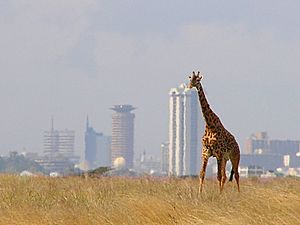
Nairobi is one of the few cities in the world with a national park within its boundaries, making it a prime tourist destination as well, with several other tourist attractions.
The most famous is the Nairobi National Park, the only game reserve of this nature to border a capital city, or any major city. The park contains many animals including lions, giraffes, and black rhinos. The park is home to over 400 species of birds. The Nairobi Safari Walk is a major attraction to the Nairobi National Park as it offers a rare on-foot experience of the animals.
Nairobi is home to several museums, sites, and monuments.
Nairobi is nicknamed the Safari Capital of the World or the Green City in the Sun, and has many hotels to cater for safari-bound tourists.
Nairobi is also home to the largest ice rink in Africa: the Solar Ice Rink at the Panari Hotel's Sky Centre. The rink, opened in 2005, covers 1,400 square metres (15,000 sq ft) and can accommodate 200 people.
Nairobi's night life is popular with tourists, young and old. From a collection of gourmet restaurants offering local and international cuisine, Nairobi has something to offer to every age and pocket. Most common known food establishments include The Carnivore and The Tamarind Restaurants which have outlets in Langata, City Centre, and the Village Market. For those more discerning travellers, one can choose from a wide array of local cuisine, Mediterranean, fast food, Ethiopian, and Arabian.
Other sites include Jomo Kenyatta's Mausoleum, Kenya National Theatre, and the Kenya National Archives. Art galleries in Nairobi include the Rahimtulla Museum of Modern Art (Ramoma), the Mizizi Arts Centre, and the Nairobi National Museum.
Society and culture
Nairobi is a cosmopolitan and multicultural city. The names of some of its suburbs, including Hurlingham and Parklands reflect Nairobi's early history of colonial occupation.
By the mid twentieth century, many foreigners settled in Nairobi from other parts of the British Empire, primarily India and parts of (present-day) Pakistan. These immigrants were workers who arrived to construct the Kampala – Mombasa railway, settling in Nairobi after its completion, and also merchants from Gujarat. Nairobi also has established communities from Somalia and Sudan.
There are a number of churches, mosques, temples, and gurdwaras within the city. Prominent places of worship in Nairobi include the Cathedral Basilica of the Holy Family, All Saints Cathedral, Ismaili Jamat Khana, and Jamia Mosque.
Nairobi has two informal nicknames. The first is "The Green City in the Sun", which is derived from the city's foliage and warm climate. The second is the "Safari Capital of the World", which is used due to Nairobi's prominence as a hub for safari tourism.
There are a number of shopping malls in the Nairobi Area. These include: Garden city mall, Thika road mall (TRM), the West Gate mall, Prestige Plaza, the Village Market, the Sarit Centre, the Junction, Rosslyn Riviera mall, Two Rivers mall. A variety of amenities are provided at these malls and include: cinemas, fashion and apparel retailers, bookshops, electronics and grocery stores, coffeehouses and restaurants.
Food
In Nairobi, there are a range of restaurants. Besides being home to nyama choma which is a local term used to refer to roasted meat, there are American fast food restaurants such as KFC, Subway, Domino's Pizza, Pizza Hut, Hardee's and Burger King, and the longer established South African chains, Galitos, Steers, PizzaMojo, and Spur Steak Ranches. Coffee houses, doubling up as restaurants and mostly frequented by the upper middle classes, such as Artcaffe Nairobi Java House and Dormans, have become increasingly popular in recent days. Traditional food joints such as the popular K'osewe's in the city centre and Amaica, which specialize in African delicacies, are also widespread. The Kenchic franchise which specialized in old-school chicken and chips meals was also popular, particularly among the lower classes and students, with restaurants all over the city and its suburbs. However, as of February 2016, Kenchic stopped operating its eatery business. Upscale restaurants often specialize in specific cuisines such as Italian, Lebanese, Ethiopian, and French, but are more likely to be found in five star hotels and the wealthier suburbs in the West and South of the city.
Nairobi has an annual restaurant week (NRW) at the beginning of the year, January–February. Nairobi's restaurants offer dining packages at reduced prices. NRW is managed by Eatout Kenya which is an online platform that lists and reviews restaurants in Nairobi, and provides a platform for Kenyan foodies to congregate and share.
Music
Nairobi is the centre of Kenya's music scene. Benga is a Kenyan genre which was developed in Nairobi. The style is a fusion of jazz and Luo music forms. Mugithi is another popular genre in Kenya, with its origins in the central parts of the country. A majority of music videos of leading local musicians are also filmed in the city.
In the 1970s, Nairobi became the prominent centre for music in the African Great Lakes. During this period, Nairobi was established as a hub of soukous music. This genre was originally developed in Kinshasa and Brazzaville. After the political climate in the region deteriorated, many Congolese artists relocated to Nairobi. Artists such as Orchestra Super Mazembe moved from Congo to Nairobi and found great success. Virgin records became aware of the popularity of the genre and signed recording contracts with several soukous artists.
More recently, Nairobi has become the centre of the Kenyan hip hop scene, with Kalamashaka, Gidi Gidi Majimaji being the pioneers of urban music in Kenya. The genre has become very popular amongst local youth, and domestic musicians have become some of the most popular in the region. Successful artists based in Nairobi include Jua Cali, Nonini, Camp Mulla, Juliani, Eric Wainaina, Suzanna Owinyo and Nameless. Popular record labels include Ogopa DJs, Grand Pa Records, Main Switch, Red Black and Green Republik, Calif Records and Bornblack Music Group.
Many foreign musicians who tour Africa perform in Nairobi. Bob Marley's first-ever visit to Africa started in Nairobi. Acts that have performed in Nairobi include Lost Boyz, Wyclef Jean, Shaggy, Akon, Eve, T.O.K, Sean Paul, Wayne Wonder, Alaine, Konshens, Ja Rule, and Morgan Heritage, and Cabo Snoop. Other international musicians who have performed in Nairobi include the rocking show by Don Carlos, Demarco, Busy Signal, Mr. Vegas and the Elephant man crew.
Nairobi, including the coastal towns of Mombasa and Diani, have recently become the centre of EDM in Kenya, producing DJs as well as producers like Jack Rooster, Euggy, DJ Fita, Noise on Demand, DJ Vidza, DJ Coco EM. Prominent international composers and DJs have also toured in Nairobi, including Diplo, Major Lazer, Kyau & Albert, Solarity, Ronski Speed, and Boom Jinx.
Many nightclubs in and around the city have witnessed a growth in the population that exclusively listen to Electronic Dance Music, especially amongst the younger generations. These youth also support many local EDM producers and DJs, such as Jahawi, Mikhail Kuzi, Barney Barrow, Jack Rooster, HennessyLive, Trancephilic5 As well as up and comers such as L.A Dave, Eric K, Raj El Rey, Tom Parker and more.
Gospel music is also very popular in Nairobi just as in the rest of Kenya, with gospel artistes having a great impact in the mostly Christian city. Artistes such as Esther Wahome, Eunice Njeri, Daddy Owen, Emmy Kosgei and the late Angela Chibalonza, among others, have a great pull over the general population while others like MOG, Juliani, Ecko dyda, DK Kwenye Beat have great influence over the younger generation. Their concerts are also very popular and they have as much influence as the great secular artistes. The most popular are Groove tours, TSO (Totally Sold Out) new year concerts.
Musical group Sauti Sol performed for U.S. President Barack Obama when he was in the city for the 2015 Global Entrepreneurship Summit.
Sport
Nairobi is the African Great Lakes region's sporting centre. The premier sports facility in Nairobi and generally in Kenya is the Moi International Sports Centre in the suburb of Kasarani. The complex was completed in 1987, and was used to host the 1987 All Africa Games. The complex comprises a 60,000 seater stadium, the second largest in the African Great Lakes (after Tanzania's new national stadium), a 5,000 seater gymnasium, and a 2,000 seater aquatics centre.
The Nyayo National Stadium is Nairobi's second largest stadium renowned for hosting global rugby event under the "Safaricom Sevens." Completed in 1983, the stadium has a capacity of 30,000. This stadium is primarily used for football. The facility is located close to the Central Business District, which makes it a convenient location for political gatherings.
Nairobi City Stadium is the city's first stadium, and used for club football. Nairobi Gymkhana is the home of the Kenyan cricket team, and was a venue for the 2003 Cricket World Cup. Notable annual events staged in Nairobi include Safari Rally , Safari Sevens rugby union tournament, and Nairobi Marathon.
Football is the most popular sport in the city by viewership and participation. This is highlighted by the number of football clubs in the city, including Kenyan Premier League sides Gor Mahia, A.F.C. Leopards, Tusker and Mathare United.
There are six golf courses within a 20 km radius of Nairobi. The oldest 18-hole golf course in the city is the Royal Nairobi Golf Club. It was established in 1906 by the British, just seven years after the city was founded. Other notable golf clubs include the Windsor Country Club, Karen Country Club, and Muthaiga Golf Club. The Kenya Open golf tournament, which is part of the European Tour, takes place in Nairobi. The Ngong Racecourse in Nairobi is the centre of horse racing in Kenya.
Rugby is also a popular sport in Nairobi with 8 of the 12 top flight clubs based here.
Basketball is also a popular sport played in the city's srimary, Secondary and college leagues. Many of the city's urban youth are basketball fans and watch the American NBA.
Images for kids
-
A giraffe at Nairobi National Park, with Nairobi's skyline in background
-
View of Kibera, Nairobi
See also
 In Spanish: Nairobi para niños
In Spanish: Nairobi para niños



